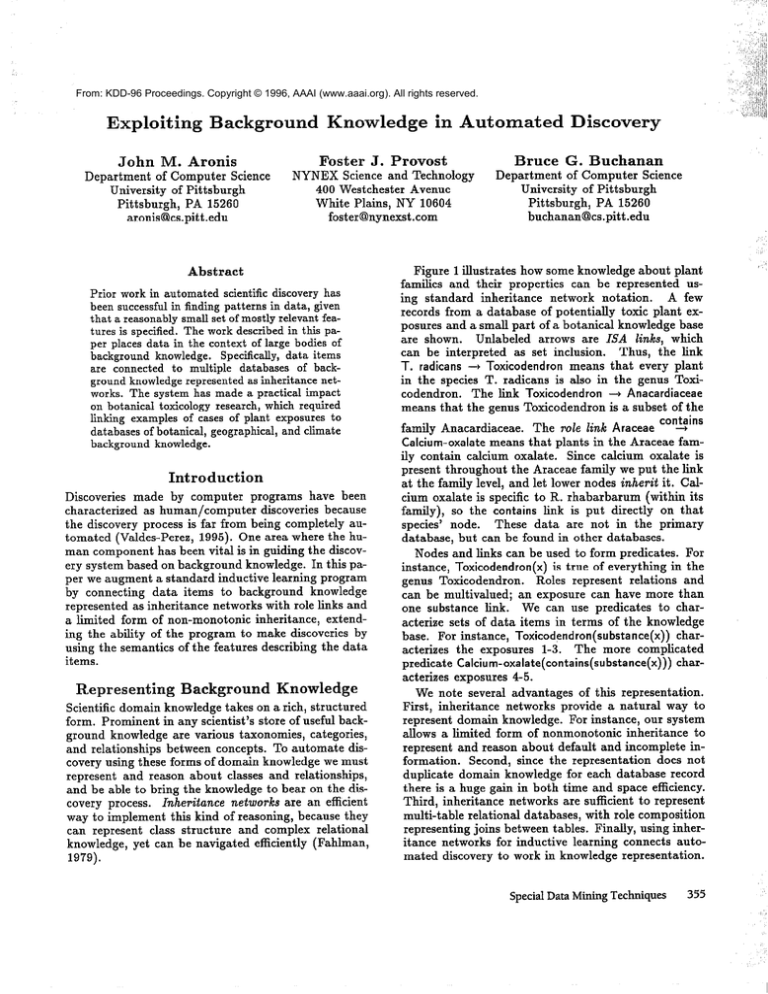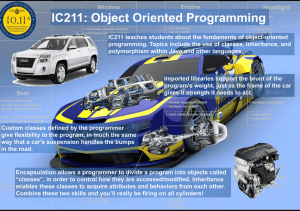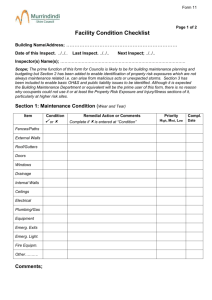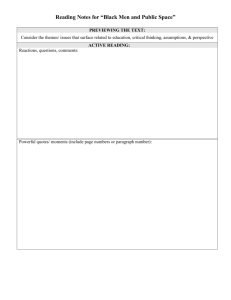
From: KDD-96 Proceedings. Copyright © 1996, AAAI (www.aaai.org). All rights reserved.
Exploiting
John
M.
Background
Aronis
Department of Computer Science
University of Pittsburgh
Pittsburgh, PA 15260
aronisQcs.pitt.edu
Knowledge
Foster
Prior work in automated scientific discovery has
been successful in finding patterns in data, given
that a reasonably small set of mostly relevant features is specified. The work described in this paper places data in the context of large bodies of
background knowledge. Specifically, data items
are connected to multiple databases of background knowledge represented as inheritance networks. The system has made a practical impact
on botanical toxicology research, which required
linking examples of cases of plant exposures to
databases of botanical, geographical, and climate
background knowledge.
Introduction
Discoveries made by computer programs have been
characterized as human/computer
discoveries because
the discovery process is far from being completely automated (Valdes-Perez, 1995). One area where the human component has been vital is in guiding the discovery system based on background knowledge. In this paper we augment a standard inductive learning program
by connecting data items to background knowledge
represented as inheritance networks with role links and
a limited form of non-monotonic inheritance, extending the ability of the program to make discoveries by
using the semantics of the features describing the data
items.
Background
J. Provost
NYNEX Science and Technology
400 Westchester Avenue
White Plains, NY 10604
foster@nynexst.com
Abstract
Representing
in Automated
Knowledge
Scientific domain knowledge takes on a rich, structured
form. Prominent in any scientist’s store of useful background knowledge are various taxonomies, categories,
and relationships between concepts. To automate discovery using these forms of domain knowledge we must
represent and reason about classes and relationships,
and be able to bring the knowledge to bear on the discovery process. Inheritance networks are an efficient
way to implement this kind of reasoning, because they
can represent class structure and complex relational
knowledge, yet can be navigated efficiently (Fahlman,
1979).
Bruce
Discovery
G. Buchanan
Department of Computer Science
University of Pittsburgh
Pittsburgh, PA 15260
buchananOcs.pitt.edu
Figure 1 illustrates how some knowledge about plant
families and their properties can be represented using standard inheritance network notation.
A few
records from a database of potentially toxic plant exposures and a small part of a botanical knowledge base
are shown. Unlabeled arrows are ISA links, which
can be interpreted as set inclusion.
Thus, the link
T. radicans --f Toxicodendron
means that every plant
in the species T. radicans is also in the genus Toxicodendron. The link Toxicodendron
--f Anacardiaceae
means that the genus Toxicodendron is a subset of the
con2ins
family Anacardiaceae. The role link Araceae
means that plants in the Araceae famCalcium-oxalate
ily contain calcium oxalate. Since calcium oxalate is
present throughout the Araceae family we put the link
at the family level, and let lower nodes inherit it. Calcium oxalate is specific to R. rhabarbarum (within its
family), so the contains link is put directly on that
species’ node. These data are not in the primary
database, but can be found in other databases.
Nodes and links can be used to form predicates. For
instance, Toxicodendron(x)
is true of everything in the
genus Toxicodendron.
Roles represent relations and
can be multivalued; an exposure can have more than
one substance link. We can use predicates to characterize sets of data items in terms of the knowledge
base. For instance, Toxicodwdron(substance(x))
characterizes the exposures l-3. The more complicated
predicate Calcium-oxalate(contains(substance(x)))
characterizes exposures 4-5.
We note several advantages of this representation.
First, inheritance networks provide a natural way to
represent domain knowledge. For instance, our system
allows a limited form of nonmonotonic inheritance to
represent and reason about default and incomplete information. Second, since the representation does not
duplicate domain knowledge for each database record
there is a huge gain in both time and space efficiency.
Third, inheritance networks are sufficient to represent
multi-table relational databases, with role composition
representing joins between tables. Finally, using inheritance networks for inductive learning connects automated discovery to work in knowledge representation.
Special Data Mining Techniques
355
l/yy
Araceae
Anacardiacaae
Polygonaceae
0
co lains
2-l
I
Toxlcodendron
0
/
A
clclcl
T. radicans
q
T. vemlx
T. dlversilobum
A. dracontlum
t
Arisaema
2
/
q
17
C. serrulata
A. btphyllum
\A\
Cleome
cl
2
I
cl
C. veridiflom
wb/nc6
ince
Rheum
cl
2
1
0
0
R. rhapontlcum
R. rhabarbarum
/
I
Database
Exposure-l
Exposure-2
Exposure-3
Exposure-4
Exposure-5
Exposure-6
Figure 1: Linking Data to Botanical Knowledge.
An
Illustrative
Example
Consider the network in Figure 2. Six examples of
Datura exposures are shown, connected to a database
of geographical and climate knowledge. Datura exposures normally occur in August-October;
here we
are interested in characterizing an anomalous subset
of toxic exposures that occur in May. The KnowledgeBased Rule Learner (KBRL) starts with general predicates and attempts to specialize them. The user defines
criteria with which the system will judge a discovery
to be interesting. For this example, we use the simple
criteria: an interesting pattern is one that covers all of
the May exposures, and none of the 0thers.l
The search starts with the general predicate
US(location(x)).
Since testing reveals that this is an
overly general characterization, its speciaZkations are
formed from relationships in the network, and are immediately tested:
Southeast(location(x))
Southwest(location(x))
The first predicate fails to cover any members of the
concept class in the database, so the system rejects it.
The second correctly excludes some of the complement
of the concept class, while still covering the incidents
we are interested in categorizing, so the system retains
it. However, since this predicate still covers part of
the complement, the system tests each of its specializations:
‘Of course, discovering a pattern characterizing a concept is seldom this simple. Predicates have to be evaluated
statistically,
and the concept will usually be covered only
partially or covered by a disjunction of predicates.
356
Technology Spotlight
Nevada(location(x))
Arizona(location(x))
Neither of these have adequate coverage-they
reject
items in the concept class-so the system rejects them
and looks for other ways to specialize the current hypothesis. The system cannot use the hierarchy of locations to refine its hypothesis any further, so it tries
the zone link. Retaining the predicate already found,
it forms the rule:
Southwest(location(x))
& AnyZone(zone(location(x)))
Again, the additional predicate is vacuous, so it is specialized to create the three hypotheses:
Southwest(location(x))
& Hot(zone(location(x)))
Southwest(location(x))
& Mild(zone(location(x)))
Southwest(location(x))
& Cold(zone(location(x)))
Checking each of these verifies that the first characterizes the May incidents perfectly, so it is retained as a
characterization that satisfies the system’s criteria for
an interesting discovery.
Some Details
of the Algorithm
KBRL, based on the RL learning program (Clearwater
& Provost, 1999), performs a general-to-specific heuristic search for a set of conjunctive rules that satisfy userdefined rule evaluation criteria.
At each stage of the
search, KBRL specializes the currently most promising
rules by either restricting their predicates, or adding
new ones to the conjunction on the left-hand side of
the rule. KBRL starts with the rule T(x) --) C(x),
where T(x) is the most general concept in the knowledge base (true of everything), asserting that everything is a member of the concept C. KBRL performs
cl
Nevada
0
Arizona
0
N. Carolina
0
Flyida
Cold
EXpOSW-I
Exposure-2
WPU
WY)
Exposure-3
(May)
Exposure-4
WY)
Exposure-5
Km.)
Figure 2: Characterizing
an n-best search through the space of rules defined by
the following specialization
operators:
The rule . . . P(fn . . .fl(x)) . . . --+ C(x) can be spe. . & T(x) +
cialized to the rule . . . P(fn . . .fl(x)).
C(x)*
Given a rule of the form . . . P(fh . . .fl(x)) . . . --+
C(x) and ISA links P1 --) P,. . ., Pn + P in the
. . + C(x)
network, the rules . . . Pl(fn . . .fl(x)).
through . . . Pn (fn . . .fl(x)) . . . + C(x) are specializations.
If the node P has f role values which are restricted
. . + C(x) specialto P’, the rule . . . P(fn . . .fl(x)).
izes to.. . P(fn . . .fl(X)) & P’(f,+lf”
. . .fl(X)) . . . --)
C(x)*
The first operator-Add
a Predicate-allows
us to add
additional predicates to a rule. This allows us to form
rules with several conjuncts. The second operatorSpecialize a Predicate-searches
downward through a
network identifying classes of the concept. It is important to note that in some cases there will be several
different classifications of items. In botany, for example, there are different hierarchies based on different
approaches to classification. The KBRL search algorithm explores all of these, specializing predicates according to each hierarchy and using heuristics to guide
the search down paths that make meaningful distinctions in the current context.
The third operatorRestrict a Role-selects a set of items based on their
1
Exposure-6
WPU
May Datura Exposures.
relationship to other parts of the knowledge base. Notice that the third operator is recursive, and we can
restrict the predicate P(x) to P’(f(x)),
P”(gf(x)),
etc.
Thus, we can talk about concepts such as “the average
annual rainfall of the location of the exposure.”
Membership in interesting classes may be determined by exceptional information, so it is important
to incorporate and use some form of nonmonotonic information. We currently use a simple form of default
inheritance that allows role values to be overridden by
more specific information.
Consider the diagram in
Figure 3. The items in the concept, marked by “+“,
are characterized by the predicate Qz(f(X)).
This includes every item in Pz, which all have f’s that default
to Q2, as well as 13, which has an exceptional f value.
An Application
to Botanical
Toxicology
We have been working with botanical toxocologists to
analyze a database of potentially toxic plant exposures
(Krenzelok, et al., 1995a,b,c). KBRL was applied to
these data linked to a knowledge base of geographic areas and their climates constructed from several sources
on the World Wide Web.
As an example of the flexibility of learning with
background knowledge represented as an inheritance
hierarchy, consider the geographic knowledge base,
which consists of approximately
1000 geographic regions. The smallest, most specific region is a “zip code
area”-a
geographically contiguous set of zip codes
Special Data Mining Techniques
357
‘,
i
.,
‘,
‘,
q
P-
f q lQl
P
4
\
iIlL
f
Figure 3: A Relation with an Exception.
that share the same first three digits. Zip code areas are arranged into a hierachy, with upper levels for
states and geographic regions. Climate data, including rainfalL solarization, soil conditions, and temperatures, are linked to nodes in the geographic hierarchies
by role links. In most cases, KBRL reasons about similarities in climate conditions by utilizing the exposure
records’ zip-code fields. However, some exposures are
missing the zip code, but do have the telephone area
code. Fortunately, KBRL can key into the geographic
knowledge base at a less detailed level using the telephone area code.
The inheritance hierarchy allows the use of the most
specific climatic information possible. The nodes at
the lowest level do not all have complete information,
so some information must be inherited from the state
level. Although information at the state level is complete, it tends to be approximate.
W e also used a
knowledge base of botanical species, genera, and families adapted from a U. S. Department of Agriculture
database. Several small hierarchies of demographic
factors, treatment patterns, etc., were also used.
One area of investigation in which KBRL took part
was a study of exposures to Datura species. Many
of the rules KBRL found refined the existing model
of a seasonal spread of Datura exposures, but were
not surprising to our botanical and toxicology collaborators. Rules showing that Datura exposures peak
later in colder areas than in warm areas are a reflection of the fact that plants take longer to mature in
colder climates. Other rules, such as a surprising degree of Datura abuse in some states, were unexpected
but could have been found by other methods. A new
rule was found that characterizes an unexpected set
of May exposures in terms of basic enviromental conditions. This new rule was judged significant by our
collaborators in botany and toxicology (Krenzelok, et
al., 1995b).
358
TechnologySpotlight
Discussion
KBRL extends the notion of tree-structured attributes
(Almuallim, Akiba & Kaneda, 1995) by allowing values to reference into multiple ISA hierarchies, complete
with role relations and inheritance. However, the expressiveness of KBRL’s language is currently limited to
binary relational terms, and thus is not as expressive
as some existing inductive logic programming systems
(Muggleton, 1992). The design of KBRL purposely
chose efficiency over expressiveness when it came to
decisions about particularly expensive constructs, such
as n-ary and recursive relational terms. On the other
hand, because it was crucial for applications with incomplete data, KBRL incorporates default inheritance,
which is difficult to deal with naturally in other relational systems. However, KBRL’s form of nonmonotonic inheritance is limited, and will be difficult to extend since we want to allow multiple values and multiple ISA inheritance with negation.
Acknowledgements
This research was supported by National Science Foundation grants IRI-9412549, BES-9315428, and by the
W . M. Keck Foundation.
References
Almuallim, H., Akiba, Yasuhiro, A., and Kaneda S.
(1995). On Handling Tree-Structuree Attributes in
Decision Tree Learning. In Proceedings of the Twe&h
International
Conference
on Machine
Learning
(ML-
93). Morgan Kaufmann.
Clearwater, S. and Provost, F. (1990). RL4: A Tool
for Knowledge-Based Induction. In Proceedings of the
Second International IEEE Conference on Tools for
Intelligence, 24-30. IEEE C.S. Press.
Artificial
Fahlman, S. (1979). NETL: A System for Representing and Using Real-World
Knowledge. MIT Press,
Cambridge, MA.
Krenzelok, E.P., Jacobsen, T.D. and Aronis, J.M.
(1995a). Mistletoe Exposures . . .The Kiss of Death.
To appear in American JoumaI of Emergency
Medicine.
Krenzelok, E.P., Jacobsen, T.D. and Aronis, J.M.
(1995b). Jimsonweed (Datura stramonium) Poisoning
and Abuse . . . An Analysis of 1,458 Cases. Submitted
to American Journal of Emergency Medicine.
Krenzelok, E.P., F.J. Provost, Jacobsen, T.D., Aronis, J.M., and Buchanan, B.G. 1995c. Poinsettia
(Euphorbia pulcherrima) Exposures Have Good Outcomes . . . Just As W e Thought. To appear in AmeTican Journal of Emergency Medicine.
Muggleton, S. (Editor) (1992). Indzlctive Logic PTOgramming, Academic Press.
Valdes-Perez, R., (1995). Some Recent HumanComputer Discoveries in Science and What Accounts
for Them. AI Magazine, 16(3), pp. 37-44.
”
!




